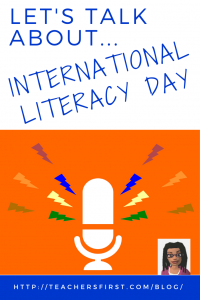
On September 8th, UNESCO asks us to pause to recognize the challenge of literacy as a human rights issue. This year, International Literacy Day events will focus on the effect of the COVID-19 crisis on teaching literacy. Literacy and problems associated with it are a significant part of the United Nations’ Sustainable Development Goals. The initial response to the COVID-19 crisis saw schools and other education programs shuttered, halting progress towards a more literate world. Through International Literacy Day celebrations and events this year, UNESCO searches for information about educators’ role and changing pedagogies that will guide strategies for delivering literacy instruction moving forward.
As instruction moved online for many students at the onset of the COVID-19 crisis, teachers faced many new challenges. Among them was recognizing the need to help students “code switch” when reading. Digital reading is very different from reading a printed book or eBook. When a student picks up a book to read, the intent is usually to read it sequentially from cover to cover. When approaching digital texts – webpages, blog posts, online articles – we have learned to skim and scan. We read for the gist of the text or to find specific information and then move on. The strategies are very different.
As we move to our instructional “new normal,” we must teach our students to read for comprehension when faced with digital texts. Below are a few strategies that will help:
Think-Alouds
Think-Alouds are a tried and true strategy that is successful at every grade level and with every content area. Use your whole group time or synchronous session to model this strategy for your students. Remember to keep this virtual session short and targeted (a good guideline is to make the meeting the same length as the student’s age) and record it so that it’s available later for those who miss the session and for review. You can also ask students to do think-alouds in their small group sessions. It will add accountability to their practice, help them to engage with the digital reading task, and help them slow down and process what they are reading.
Learning Structure & Form of Digital Texts
Understanding the structure of digital text and digital text features will also help increase comprehension of digital writing. Students need to be able to identify keywords, headings, and lists, and understand what they signal in the text. Set up a digital text feature scavenger hunt for your students using Flipgrid (reviewed here) or GooseChase (reviewed here). Not only will this enhance your instruction, but the students will also enjoy the activity. Don’t worry if you are not sure how to set up this kind of scavenger hunt. TeachersFirst®️ has you covered with this OK2Ask®️ archive on Fliphunts or this one on GooseChase.
Annotation
Teach students to engage with the text by annotating what they are reading. Model the skill for your students during a synchronous/whole group session first, then assign this lesson on annotation from Google’s Applied Digital Skills curriculum (reviewed here). Once students understand what annotation is, you can practice as a class using Edji (reviewed here). Use Fiskkit (reviewed here) for individual practice and to promote critical thinking when reading digital texts.
Map Ideas Visually
Work with students to solidify their comprehension by creating a concept map of the content. Use a concept map template, like this one from ReadWriteThink (reviewed here), to scaffold student work as they learn what a concept map is and how it demonstrates relationships. Once students can fill in your template, have them create their own using MindMup (reviewed here) or SpiderScribe (reviewed here). Concept mapping is a creative extension activity that students will find useful throughout their lives. What strategies do you use for literacy instruction? How have they changed as a result of the COVID-19 crises? Let us know in the comments below.

